Reported by:
Michael Ng Sr3A
On the 14th August of 2021, as part of the teachers’ development programme, a sharing session on multiple assessments was conducted. Teachers presented the assessments they have handed out for students and got feedback from experts in the education field.
In this article the sessions of the Geography, History, Commerce, and Chinese Language subjects will be covered.
Geography: Hands-on with Geographical Data
The Geography subject session was conducted by Mr Ng Sui Thye, Mr Kan Chun Fye, and Ms Chieng Mee Ung.
Mr Ng went first, opening his presentation with an overview of score allocations for each grade. From this, he states that multi-aspect assessments only apply for Junior Middle One, Junior MIddle Two and Senior Middle One classes, while the rest are mostly test based.
He went on to talk about the assessment for Senior Middle One students, which was a geography report based on a major city.
Students would form groups of three to four and analyse the human and physical geographical features of the city, find out its functions, think about possible problems it may have, and propose solutions. Five marks would be allocated for each criterion, totalling 20 marks.
The objective of this is to break down the encyclopedic view students have towards geography, Mr Ng said. Students would be able to experience researching and arranging information they have gathered online, as well as incorporate knowledge from Junior Level history and geography classes.
Due to the overwhelming amount of projects submitted, time would be tight if all reports had to be given full feedback, hence the current plan calls for only exceptionally good ones to be presented and given feedback. Most students are still stuck in the copy-and-paste method of researching, too, hence more care ought to be given towards teaching research techniques.
Mr Ng closed his presentation by talking about future plans for this mode of assessment, where the major cities would continue to be analysed from perspectives of future chapters, such as production.
Next up was the assessment for Junior Middle Two students, presented by Mr Kan. It involved drawing overview maps of a shop or community.
Students would have four months to complete this individually, given ten marks for the design of the map and another ten for supplementary details given, like the history of the chosen location.
Some students’ projects were shown, with some going far and beyond in designing the map and others getting improvement after feedback from teachers. However, some students handed in their work a week before the deadline, which was not enough time for feedback to be given. Additionally, a few missed out on map elements in their design.
Overall, this assessment gave an outlet for students to express, cultivate and combine various skills, such as application of historical and geographical knowledge, graphic design, interviewing skills, and observational skills. Further plans for this project include analysing the drawn maps further and setting a timetable so students could do their work step-by-step, thus avoiding late handins.
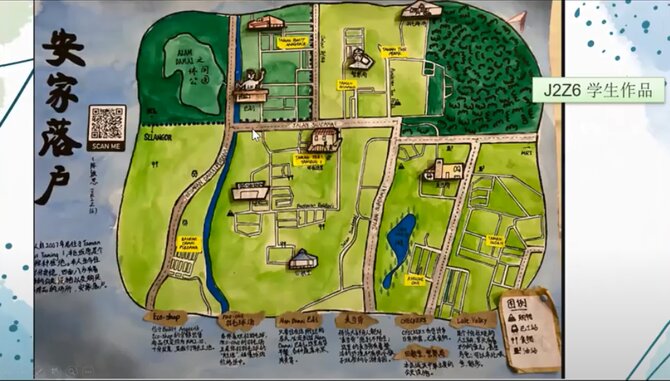 An overview map of a community area designed by a student
An overview map of a community area designed by a student
Next up, Ms Chieng introduced the assessments assigned for Junior Middle One students, which involved a month-long weather report.
In groups of four to five, they need to record the daily highest and lowest temperatures of an area from 1 March to 12 April, then calculate the diurnal air temperature variation, daily mean temperature, and monthly mean temperature. This data would then need to be tabulated and, along with a map of their researched location, presented on a manila card.
Again, 20 marks would be given for this project, with four base marks for handing it in, ten for content, three for creativity and three more for cooperation.
This assessment aims to teach students how to observe weather and utilise weather based applications on their phones. The three temperature calculations needed would also come in handy in exams as they are commonly asked in them.
How would students benefit from this? Ms Chieng explained that leadership, confidence and teamwork could be earned through working in groups; creativity could be cultivated through designing the data tabulation; and punctuality could be taught due to a mark being docked for every day the assessment is handed in late.
Ms Chieng also said that this would not eat up much class time as it is done after school hours, and that the assessment could be improved by assigning it individually and having students arrange their data on a calendar.
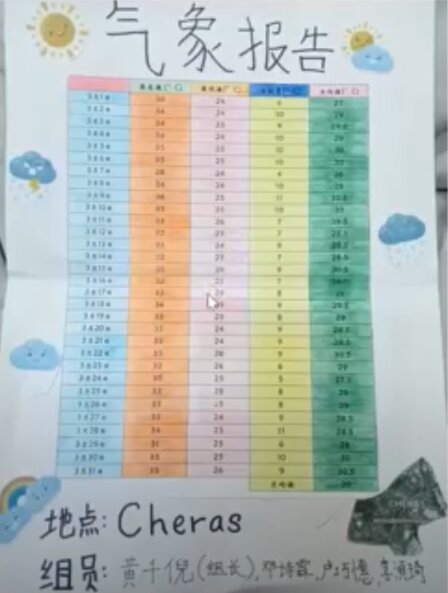 A student’s month-long weather report
A student’s month-long weather report
Dr Teoh Hee Chong then provided his two cents in the teachers’ presentations, stating that the range of marks given could be widened to 200 to 300 so that a student’s abilities and understanding in a subject could be “mapped” more accurately. He also implores teachers to standardise their naming conventions for streamlining purposes between departments, and to think about how long these assignments take to mark, as if they take too long students would not be able to receive feedback in a timely manner.
History: Bringing History Down to Earth
Ms Chen Jia Yee, Ms Yong King Lih, and Ms Lim Poh Ling were in charge of the history subject sharing sessions.
Ms Chen began her department’s session by first stating that alternative assessments needed not grand scale projects, and could be conducted in everyday classes through applications like Kahoot and Edpuzzle. Google Forms have also been used to evaluate students’ understanding with quizzes after every chapter. With that sentiment in mind, no particular assessments were assigned for Junior Level students.
However, Ms Chen wanted to introduce the Dong Zong mandated history report that every Junior Middle Two student has to carry out, as she believed that it counted as a form of multi-aspect assessment. This year’s report theme is based on our local arts sector and artists. This assessment not only tests students on their information searching and design skills, but also their attitude and time management in the project, hence evaluating students from multiple perspectives.
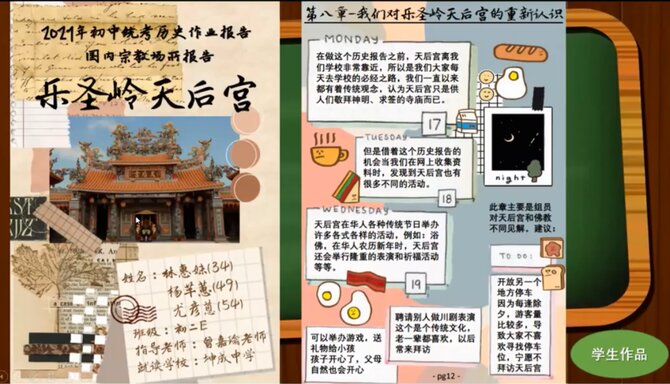 History reports from the past year
History reports from the past year
Next, Ms Yong talked about the assessments given for Senior Middle Two students, which was about running a Facebook page.
Due to history classes being limited in number and forced to stick heavily to the syllabus, this continuation of an activity from last year aims to encourage students to analyse, structure and comment on historical points, making history no longer a “dead” subject.
Four to five students ran their own Facebook page on world history, with Sr2A students focusing on special topics while Sr2B and Sr2C students focusing on introducing a country. Marks would not only be given for the Facebook content itself, but also for interacting with pages from other classes.
Ms Yong then shared some example student-run Facebook pages, including some from last year that focused on Chinese history specifically. The posts were no doubt high quality, with some even producing full-on videos.
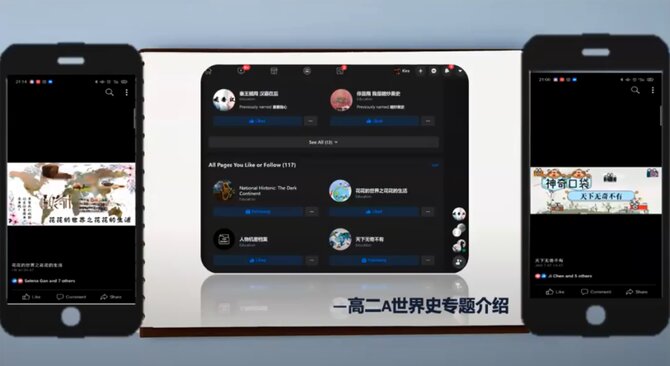 Some Facebook pages created by the students
Some Facebook pages created by the students
Moving on, Ms Lim talked about her project for Senior Middle One students which involved “bringing life to national treasures” (让国宝活起来). To relate to the Senior Middle One syllabus of East Asian history, “national treasure” here refers to mainland Chinese relics specifically.
The idea for this activity stemmed from two problems Ms Lim noticed in Malaysia: one, souvenirs featuring our national treasures are uncreative; two, true national treasures are tucked away in museums and inaccessible.
Hence, she aimed to bring relics down to earth with two activities: a video making activity, and a cultural product designing activity.
The video making activity planned to have students form groups and pick a relic from the Chinese variety show “National Treasure” and make a four minute long video introducing it. The video must include the relic’s history, its preservation status, and what’s in store for it now. All videos would be posted on YouTube, where the group with the most liked video would receive a certificate.
The cultural product designing activity requires students to design products based on cultural relics. Students have to include the product’s design, design inspiration and background, as well as its uses.
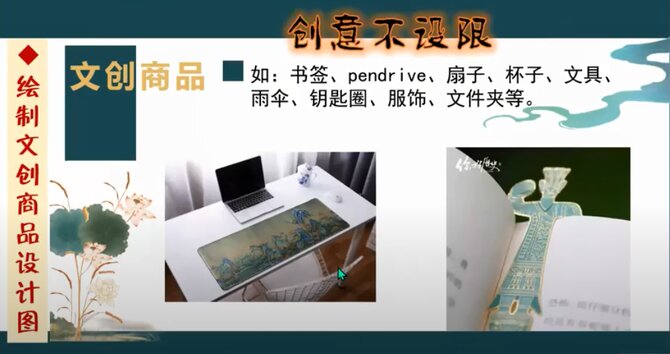 Examples of cultural products
Examples of cultural products
10 marks would be allocated for the former activity and 5 for the latter.
These activities aim to cultivate students’ skill sets from various aspects, for example the video making activity can improve a student’s language use, musical ability and logical ability as they need to summarise information found on a national relic into a 4 minute video while adding suitable background music.
Though this project would not eat up too much class time, a different problem faced was students not being proactive enough in updating their progress. As for whether this project would be continued into the next year, only time would tell.
Guest commentator, Principal Lee Lin Hui gave some comments, praising Ms Chen for her attitude towards these assessments, saying that the important thing was for students to cultivate their historical thinking skills.
Furthermore, she said that Ms Lim’s projects for Senior Middle One students may be greatly ignored by students because they are only worth a measly 15 marks. She suggested that the History Department should work together with the Commerce, Computer Studies, and Art Departments as their subjects of expertise tie into her projects in some way. She proposed that if this one project was worth 20 marks in all three of those subjects plus History, students would put more effort into them and eventually have a clearer image of the development of human history.
Commerce: Training A Businessman’s Mind
The Commerce Department was represented by its department head Mr Chan Chee Yong.
The first of the Department’s assessments was a one-page report on a certain business called 〈疫然坚强〉. It sought to implore students to care about businesses and entrepreneurs around them, as many have gone bankrupt due to the pandemic.
Students from Commerce and Arts and Commerce classes would form groups and pick a popular enterprise from the three assigned to their year group; Senior Ones getting fast food chains, Senior Twos getting bubble tea or yoghurt shops, and Senior Threes getting hotpot shops.
The report requires students to research their business’s background and formation, analyse its marketing mix (Product, Price, Place, Promotion), provide a SWOT analysis (Strengths, Weaknesses, Opportunities, Threats), then give their own opinions for the business. Teachers would play little to no role in guiding the students so they would have to utilise their self-directed learning skills.
This project aims to cultivate students’ information gathering and analytical skills. Its design also deliberately confines it to one page as they wanted students to prioritise quality over quantity; say more with less.
Sample reports from all three year groups were shown, all brimming with creativity and heart put into answering them even with a clear difference in skill level.
Another activity the Commerce Department held was letting students make their own educational videos based on the syllabus and sharing them to students from other classes.
The inspiration for this stemmed from students having a hard time understanding a teacher’s teachings but being able to instantly get something if a peer said it. Students also tend to give more concise and relatable answers.
Students can benefit from this activity because they can revise the material and train their presentation skills. Meanwhile, teachers benefit by understanding how much a student understands the chapter from their created videos, as well as taking pointers from students as to what explanation method works in getting a point across.
Other than that, commerce classes also have frequent Q&A sessions during class time, utilise applications like Quizziz and Kahoot for pop quizzes, as well as include Higher Order Thinking Skills (HOTS) based questions in their midterms and finals.
Principal Lee appreciated the Department’s sentiment of students not directly getting answers in the 〈疫然坚强〉project.
Chinese Language: Falling in Love with Reading, Writing and Culture
The Chinese Language subject sharing session was presented by another department head, Mr Lian Jit Jing,
He first introduced the marks allocation for the Chinese Language subject, where 15 marks would go towards multi-aspect assessments. Among these assessments included text read-alouds, Chinese cultural activities, and education activities on Padlet.
The text read-aloud activity was a collaborative effort with the Library Department. Students were tasked to record themselves reading a text out loud and to edit it into a video full with background music, effects, and subtitles. Mr Lian played two sample clips of this.
This not only aimed to replace class read-alouds that have not been possible in the pandemic, but also let students have an early impression of the text before they were taught. Students would be able to have an idea of the plot and emotions in it beforehand, helping in their self-directed learning.
A similar activity involving a class book sharing session was planned to be held, but had to be cancelled due to the pandemic.
Next on the list was various assignments pertaining to Chinese cultural activities, each being held differently by every teacher.
Among the assignments given were designing a calendar based on Chinese cultural festivities throughout the year, researching the history behind one’s name, and recording oneself singing a song in a Chinese dialect, dubbed “寻找消失的乡音”.
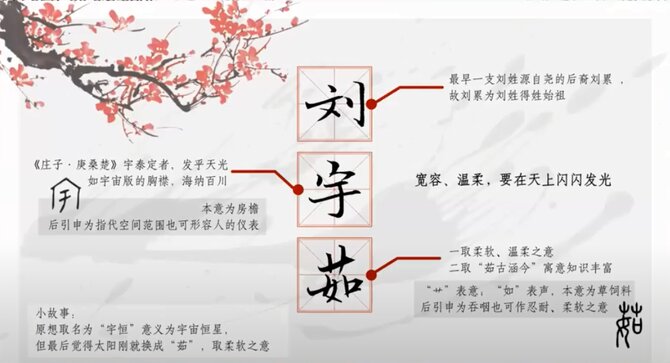 An analysis between the history of a student’s name
An analysis between the history of a student’s name
These activities helped in training students’ cognitive and creative skills, as well as imploring them to look deeper into their own culture. To bring it back down to earth, a student even said that their teacher’s Chinese cultural festivities calendar helped with jogging their memory last minute during a quiz.
Padlet has also been a source of alternative assessments being handed out to students. Teachers have tasked students with finding information about fossils or writing beautiful sentences and posting it onto the application for the whole class to see.
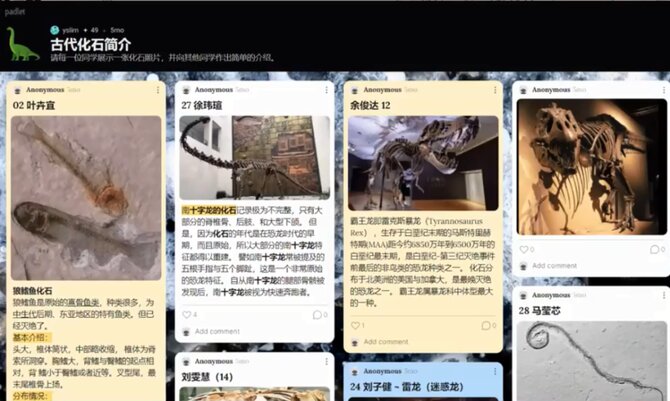 Fossils being discussed on Padlet
Fossils being discussed on Padlet
